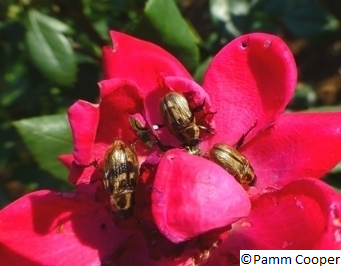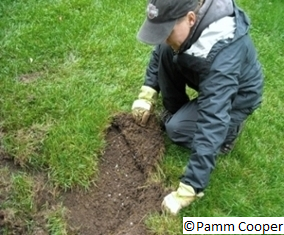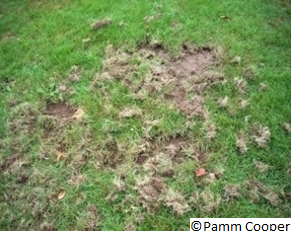One of the most commonly-encountered insect pests of turf in the North East are the larva of certain scarab beetles. These white grubs feed on the roots of grasses and other plants and damage can be severe when large numbers are present. Detection of grubs can be difficult when grass is dormant or when rainfall or irrigation keep grass green while grubs are feeding below the ground.
Adult Beetles
Most beetles that are turf pests are non-native. Japanese beetles, European chafers, Oriental beetles and Asiatic garden beetles are the most common turf damaging beetle pests found in Connecticut. Some are night flyers and can be attracted to lights, while Japanese beetles are active during the day and may be seen feeding on the leaves of over 300 plants.The adults of these beetles do not feed on grass leaves, however. To determine if populations of adults are in high enough numbers to be a potential grub problem in lawns, scouting can be done. Monitor known food plants of adults in the area by day, or use lights to attract night- flying adults. Some years are favorable to certain species depending on weather conditions as eggs are being laid. Extended drought conditions may reduce grub populations as eggs may dry out enough to prevent hatching.
Sometimes the beetles are attracted to certain plants in the landscape (such as roses, Japanese maple, grapes, Zinnias, Mountain ash and other plants for the Japanese beetle). Females then lay eggs in the soil nearby and chronic damage from year to year may result near host plants. Removal of woody ornamentals and perennial host plants attracting adults is sometimes not practical.

Life Cycle
Understanding the life cycles of turf-damaging beetles can determine timing and selection of grub control products. The immature stages are called grubs, and they overwinter as deep in the soil below frost lines. As temperatures decline in the fall, they stop feeding and move down in the soil. In the spring they begin moving up to the root zone as soil temperatures increase. Feeding on plant roots continues until pupation, which is usually around June. Japanese beetles usually emerge from the soil as adults around July 4th in Connecticut and begin mating immediately. Eggs are laid in the soil, often on sunny slopes and in moist, light soils. Eggs are seldom laid in shady areas. Within two weeks the eggs hatch and the grubs start feeding. Feeding continues through October and may continue longer if soil temperatures remain over 50°. Grubs move deep into the soil as temperatures approach freezing and they remain there until conditions are favorable in the spring.
Control Options
Grubs can become a chronic problem in certain areas of lawns as eggs are laid in favorable areas from year-to-year. Preferred sites are usually in full sun and have light, moist soils. If this is the case, and if damage has been severe in the past, preventative treatment of these areas may be advisable. It is seldom necessary to treat an entire lawn unless damage has been a problem over extensive areas.
Chemical Control: Systemic
Timing of preventative chemical insecticide applications is critical. Systemic insecticides such as the neonicotinoids that include the active ingredients imidacloprid, chlothianidin, dinotefuran, and thiamethoxam are no longer available for homeowner use and require an applicator's license. Chlorotraniliprole and halofenozide are still available for home use and may take three weeks or longer to translocate throughout the grass plants. In the spring, applications of these products have little effect on the grubs that are present because by the time the product is in place, the grubs are too large to be killed. While pupating, grubs will not be controlled by any products. Also, products applied too early in the season may not be effective long enough to control grubs that emerge later in the year. If there is a drought when the beetles are looking to lay eggs, they may delay egg-laying for up to six weeks, as in 2015, so timing of applications may need to be delayed in order to ensure the product will be effective on grubs that hatch later than normal.
The best time to apply systemic chemical insecticides is before egg hatch or when eggs are being laid, so that the product will be in the grass roots when grubs are smallest in size. For most of the scarab pests in New England, applications should be applied around mid-June through mid-July for best results. If no preventative insecticide was used and grub damage occurs, an insecticide application from July to early August will prevent further damage from occurring in the current season. Note that halofenozide is only effective up to the third molt in grubs. If applied later than that, it will not be effective. All products used for grub control must be watered down to the root zone as soon as possible after application to enable the plant to absorb the insecticide
Chemical Control: Curatives
Grub control products are becoming more scarab grub specific, and less harmful to birds, mammals, bees and other insects. One product available to homeowners since 2010 has the active ingredient chlorantraniprole. Products with this active ingredient may be applied effectively from April to September for both curative (grubs already present) and preventative grub control. This product has no caution label and is labeled as not harmful to mammals, birds and bees. It does take longer to translocate throughout the grass plants, so apply 60-90 days (mid- April through early June) prior to expected grub activity. Three weeks prior to grub hatch is the recommended timing for the neonicotinoids.
Another grub control product available at present for curative applications is trichlorfon. This material will kill grubs within days after application, but may move quickly through light soils. It breaks down quickly within 7-10 days and must be watered to the feeding zone immediately after application. While most effective against smaller grubs, it can be used on grubs doing damage in the fall and also on grubs feeding in the spring. Effectiveness lessens as grubs increase in size. Use around wells or near bodies of water is not recommended. Avoid using before heavy rains that may move the active ingredient past the root zone.
Beneficial Nematodes
Biological control options for lawn grubs are another way to manage lawn grubs. One option is to use entomopathogenic beneficial nematodes, tiny soil dwelling roundworms, which feed on the host grub and introduce pathogenic bacteria which cause the death of the grub. Acceptable levels of control against Japanese, oriental and European chafer grubs can be achieved using the Heterohabditis bacteriophora species of nematode, commonly sold as “Hb“ nematodes. If biological controls such as Hb nematodes or Bt galleriae are used, they should be applied and watered in when grubs are already present. Nematodes will begin feeding on grubs immediately. Another biological control is the milky spore disease caused by the bacteria Paenibacillus popilliae. This is effective only on grubs of the Japanese beetle, and control can be inconsistent in the Northeast. This disease affects the digestive system of the grubs, and is non-toxic to non-target insects and humans. Its effectiveness is dependent on soil type and temperature which will affect control.
Steinernema scarabaei nematodes are also effective against many white grub species but may be hard to find. Nematodes must be applied on cloudy days or early in the morning or evening to avoid desication by the sun. They are applied live and usually must be ordered as they are not stocked at garden centers due to a very short shelf life. They should be watered in with at least ¼" of water to ½ “of water. Make sure they are watered through any thatch. The best time to apply nematodes is when grubs are in the early instars, usually during the first or second week of August in Connecticut. They may provide good control for several years.
Spring Tiphia Wasp
Tiphia vernalis Rohwer (Hymenoptera Tiphiidae), a wasp also known as the spring Tiphia, is a small parasitic wasp that attacks the older larvae or grubs of the Japanese beetle. Visit the CT Integrated Pest Management Program Spring Tiphia page for more information.The CT IPM has a great fact sheet Ornamental Plants that Help the Natural Enemies of White Grubs with suggestions for the best ornamental plants to provide nectar sources for these wasps.
Bacillus Thuringiensis
A microbial toxin, Bacillus thuringiensis (Bt) strain galleriae, has shown promise as a control for second and third instar grubs. 70% control may be achieved on some species when this product is heavily irrigated to the root zone, but trials have shown 40% control may be the average. In the near future, Bt (japanensis, or ‘buibui’) may be available. It has shown promise when oriental or Japanese beetle larvae are targeted at egg hatch.
Monitoring
As grubs must be small to ensure best results, scouting is advisable in areas where grubs have been known to be a problem in the past. When adults are seen flying after emerging from the soil, egg laying will follow after mating has taken place. Eggs hatch within 10 days to two weeks, so timing of applications of any products can be approximated
Monitoring for grubs can be challenging. Observing turf grass color alone may not indicate the presence of grubs feeding on roots, especially if rains or irrigation occur. The challenge is to monitor adult activity, whether through lights at night to attract night feeding beetles, or simply by observing known host plants for the adults and their distinctive chewing damage. Sometimes the first indication of a grub problem is when skunks or crows pull up turf as they search for the grubs that are present. Grub damage appears as irregular patches of wilted or yellowing grass, and may be masked by grass that is dormant because of heat or drought. If grubs are suspected, pull at the turf at ground level. Turf pulls up easily if roots are gone, sometimes pulling up like a carpet if grub populations are high. Sunny slopes and light, moist soils are good places to monitor, especially if plant species that are hosts for the adult beetles are nearby. Rainfall can also make locating grubs harder, as turf can remain green, or even re- root as grubs move over to undamaged areas. When drier conditions come, turf damaged by grubs will wilt sooner that well- rooted turf.
Japanese beetle adults feed on over 300 species of plants, but prefer members of the Rosaceae family. These include roses, apple, plum, hawthorn, Mountain ash, cherries, and raspberries. They are often seen skeletonizing leaves on grape and Japanese maples. Since adults don’t fly too far from the adult host plants to mate and lay eggs, grub damage to lawns can be severe where there are large numbers of host plants. This fact should be considered when selecting trees and shrubs as ornamental additions to the landscape. Native species may be less attractive to adults, but not necessarily. Birches and many annual flowers are also common hosts of Japanese beetles. Oriental beetles, usually more active in the early evening, are often found feeding in flower beds. These beetles become adults in mid- June, earlier than Japanese beetles. Often turf is damaged along the perimeters of perennial flower beds, especially those containing daisies, phlox, petunias and roses, a favorite food of the adult beetles. The larva can do severe damage to roots of both turf grasses and ornamentals.
If areas of grub feeding are irrigated, grass may recover as roots begin to grow again from the crown. In the picture below, left, 69 grubs per square foot were counted. The usual thresh hold for severe damage is 8- 10 grubs per square foot. Because this fall was wet, grass was able to re- grow roots as the grubs moved on to continue feeding. If dry conditions had occurred, the rootless grass would have wilted quickly, revealing areas of grub activity sooner.
Moles are often considered harbingers of grub activity. While it is true that moles eat grubs, their main food source is earthworms. The presence of moles does not necessarily mean that grubs are present, or in numbers high enough to warrant chemical or other control. Where mole tunnels are seen, turf can be cut in blocks a foot wide and down to a depth of a couple inches and lifted out. Inspect the root zone by shaking off soil and seeing if grubs are present. Sometimes only earthworms may be found, or larvae of other ground- dwelling insects.

Turf easily pulled back where roots have been eaten by grubs.

Turf damaged by skunk. Often the first sign of grubs is damage by animals or crows as they tear away lawn in search of grubs.
Final Considerations
If grub control products are used and seem to be ineffective, there are a few things to consider. First, timing of applications may not be correct. Most systemic products work best when applied between mid-June and August 1st. Spring applications of some products are often ineffective. Trichlorfon can be applied any time soil temperatures are above 55°, but can be watered past the root zone if soils are light or heavy rains follow an application. Milky spore may not persist through cold winters, and is most effective along the Connecticut shoreline and when used in a neighborhood effort. Remember that all products must be watered into the root zone, either to be picked up through the roots, or to be ingested by the grubs as they are feeding. Often a grub control product of any type may not get watered to the root zone due to heavy thatch. A good time to apply a grub control product may be immediately following a de-thatching or aerification operation. Grass started from seed or sod after a systemic insecticide has been applied may not be protected.
The best way to manage grubs is through sound turf management practices that keep grass in a healthy state. A healthy, dense stand of turf is better equipped to resist stress of any kind. Mowing at the optimum height for species, fertilizing and watering correctly, and correcting heavy thatch and compaction will help turf resist grub damage. Monitoring beetle activity and scouting for early damage goes a long way toward deciding if and when any grub control efforts are required.
Despite good cultural practices, pests and diseases at times may appear. Chemical control should be used only after all other methods have failed.
For pesticide information or other questions please call toll free: 877-486-6271.
Revised by the UConn Home and Garden Education Center 2016